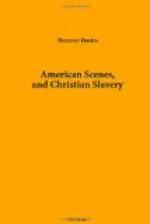“Upon the left bank of the Ohio,” continues De Tocqueville, “labour is confounded with the idea of slavery; upon the right bank it is identified with that of prosperity and improvement: on the one side it is degraded, on the other it is honoured. On the former territory no white labourers can be found, for they would be afraid of assimilating themselves to the negroes; on the latter no one is idle, for the white population extends its activity and its intelligence to every kind of improvement. Thus the men whose task it is to cultivate the rich soil of Kentucky are ignorant and lukewarm; while those who are active and enlightened either do nothing or pass over into the State of Ohio, where they may work without dishonour.”
March the 9th was a dull day; but the scenery was of surpassing beauty. At night a terrible storm of thunder and lightning, accompanied with rain, compelled us to “lie to.” A charming morning succeeded. During the forenoon, we passed a small town on the Virginia side called Elizabeth Town. An Indian mound was pointed out to me, which in size and shape resembled “Tomen y Bala” in North Wales. These artificial mounds are very numerous in the valleys of the Ohio and the Mississippi. The ancient relics they are sometimes found to contain afford abundant proofs that these fertile regions were once peopled by a race of men in a far higher state of civilization than the Indians when first discovered by the white man. The innocent and imaginative speculations of a Christian minister in the State of Ohio on these ancient remains laid the foundation of the curious book of “Mormon.”
Nature being now arrayed in her winter dress, we could form but a faint conception of her summer loveliness when clothed in her gayest green. Hills were seen rising up, sometimes almost perpendicularly from the stream, and sometimes skirted with fertile fields extending to the river’s edge. Here a house on the brow of a hill, and there another at its base. Here the humble log hut, and there the elegant mansion, and sometimes both in unequal juxtaposition. The hills are in parts scolloped in continuous succession, presenting a beautiful display of unity and diversity combined; but often they appear in isolated and distinct grandeur, like a row of semi-globes; while, in other instances, they rise one above another like apples in a fruit-vase. Sometimes the rivulets are seen like silver cords falling perpendicularly into the river; at other times, you discern them only by their musical murmurs as they roll on through deep ravines formed by their own action. These hills, for more than 100 miles before you come to Pittsburg, are literally heaps of coal. In height they vary from 100 to 500 feet, and nothing more is required than to clear off the soil, and then dig away the treasure.
What struck me most was the immense number of children everywhere gazing upon us from the river’s banks. At settlements of not more than half-a-dozen houses, I counted a groupe of more than twenty children.




